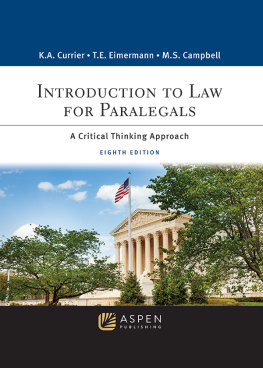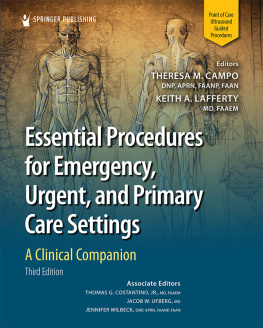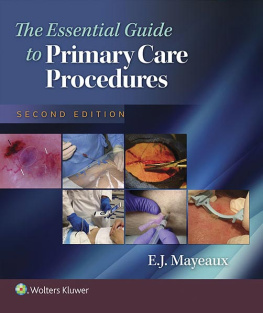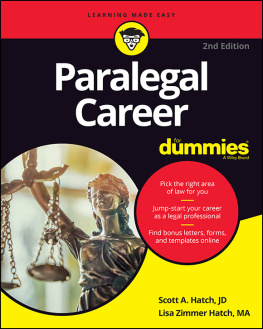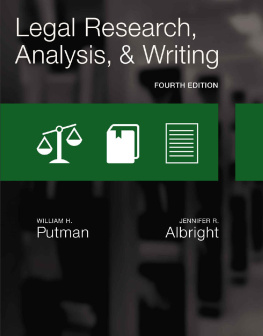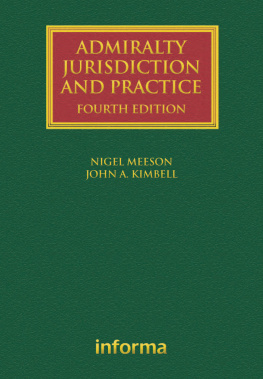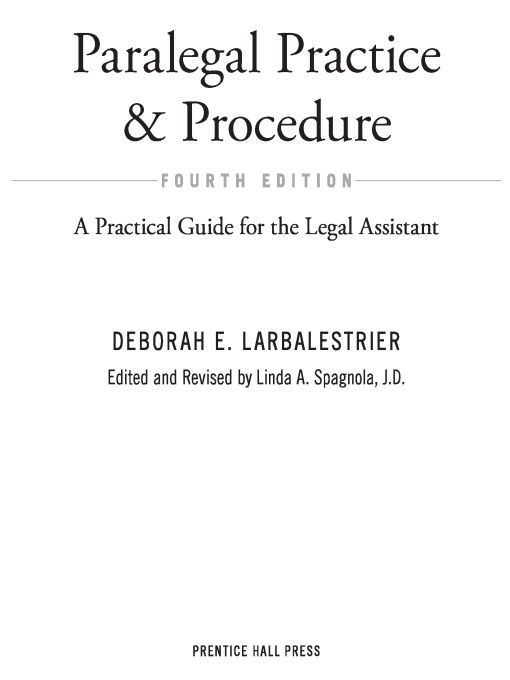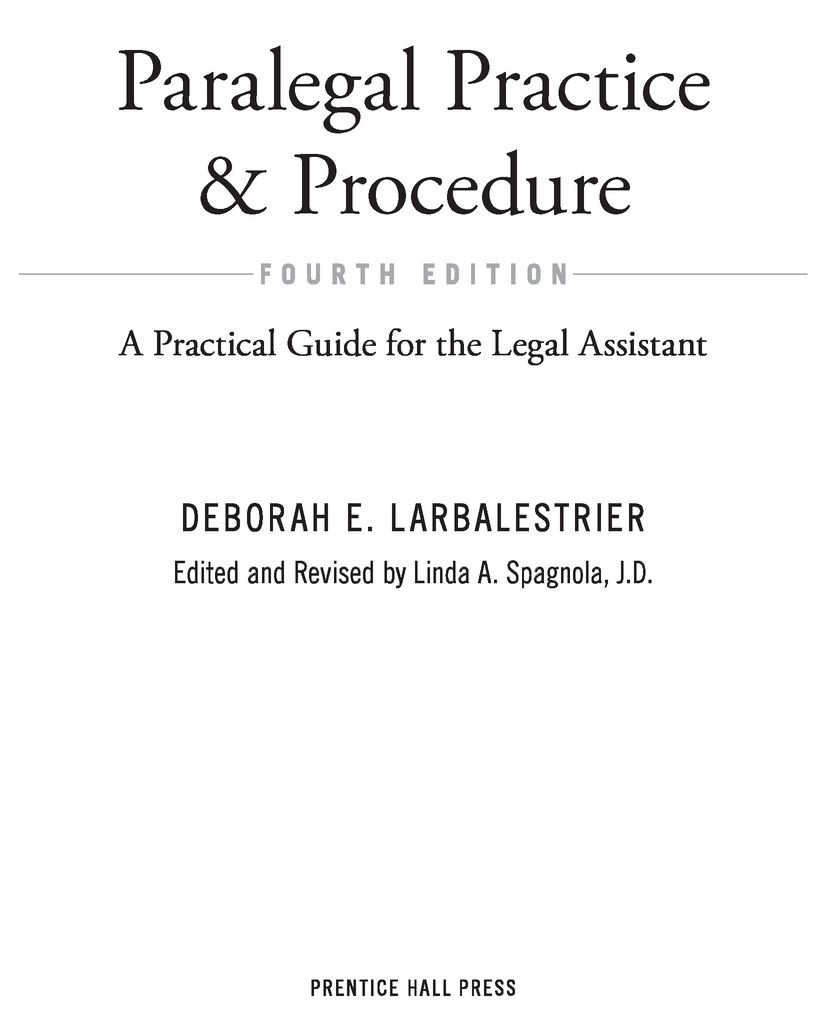Table of Contents
This book is dedicated to all those paralegals who have been influenced by Deborah Larbalestrier and all those who, through this fourth edition, will come to know her work. As the revisionist for the fourth edition, I have been moved by her dedication to the profession and consider myself privileged to have been able to work on this update.
Linda A. SPAGNOLA, ESQ.
PREFACE TO THE FOURTH EDITION
It has been more than a decade since the publication of the third edition of Paralegal Practice and Procedure and so many things have changedall of them, I am happy to report, again advancing the state of the profession. Paralegals should be proud of their accomplishments in legal practice and the justice system.
Listed below are some of the new topics covered in the fourth edition, which convey its value as a reference textbook for your office library and a reference guide for the vast and diverse sources available on the Internet.
1. The developments in each state regarding the regulation, certification, and potential licensing of paralegals and the possible implications for the profession. An updated state-by-state list with the relevant websites is included.
2. An expanded discussion on legal ethics for paralegals and their utmost importance in the legal profession. It is vitally important for the paralegal to adhere to the standards in order to preserve and protect the professionalism of paralegals.
3. We have also updated the In-House Training Program. The professional paralegal associations, International Paralegal Management Association, and ABA resources are included and/or the electronic sources are identified.
4. The Legal Research section has been completely updated reflecting the current state of electronic research, including both subscription-based and free Internet resources.
5. We have included a discussion on alternative methods of litigation such as mediation and arbitration (collectively known as ADR), with forms and formats to illustrate their use and to assist the paralegal in preparing these documents for the attorney.
6. Almost all areas of legal practice have been significantly digitized, and electronic resources are referenced in each practice section to direct the paralegal not only to these new sources, but also to information and websites relating to updating it. In this regard the importance of continuing legal education cannot be overstressed.
7. The problems and/or challenges of electronic discovery in litigation have been addressed as well as the various litigation support systems used in the law office.
8. The major changes for filing (almost solely electronically) for bankruptcy under the new rules of the Bankruptcy Abuse Prevention and Consumer Protection Act of 2005 are discussed at length, with many of the forms supplied.
9. The chapter on business organizations has been expanded to include not only corporations, but also the various other models, such as the limited liability company.
In summary, this fourth edition focuses on the information age and the consequent changes in the responsibilities and duties of paralegals. Wherever possible, we have included the electronic resources available to permit the paralegal to perform at optimum levels for thoroughness and efficiency. I have tried to stay true to the original authors organization and style so that her voice would remain in these pages.
Our best advice is to keep current and maintain the passion you have for advancing not only yourself in your career, but also the entire paralegal profession. That is what we have tried to do in writing and revising this book.
On a more personal level, I have had the opportunity to teach and work with some amazing people who are now, I am happy to say, thriving in their paralegal careers. While I may have had some part to play in their education, it is they who have inspired me to constantly strive to improve the profession as a whole. I hope that the paralegals reading this book are likewise informed and inspired.
Linda A. Spagnola, Esq.
PART ONE
General Duties, Practices, and Procedures
CHAPTER ONE
Paralegal Ethics
The Future of the Paralegal Profession
In the third edition, written more than fifteen years ago, Deborah Larbalestrier asked: What lies ahead for the paralegal profession? So much has changed in the past fifteen years that it hardly seems possible to answer that question within a single chapter. Not only have paralegals become firmly rooted as necessary to the proper functioning of the law office, but also the profession plays a vital role in the delivery of legal services. Further, since 1994, significant progress has been made in the education of paralegals. Currently, AAfPEs (American Association for Paralegal Education) membership includes over 450 universities, colleges, private schools, and institutions of higher learning, primarily in the United States, although a few members hail from Australia and Canada. Paralegals graduating from these institutions number in the hundreds of thousands and the schools currently enroll more than 50,000 students in their programs. Clearly, the paralegal profession is here to stay.
The profession has made significant strides toward recognition within both the legal community and society at large. Paralegals are well on the road to validation of professional achievement, although there is still more to be done in this regard. Formal certification of some type may benefit all concerned. The paralegal profession has demonstrated its concern for accountability to the organized bar, in the same manner and form as the public demands of attorneys. Additionally, this form of ethical procedure enhances the quality and credibility of its professional conduct. Thus far, there are only a few national paralegal associations that sponsor a certification exam. NALA (National Association of Legal Assistants) sponsors an entry level Certified Paralegal credential along with a newly introduced Advanced Paralegal Certification. NFPA (National Federation of Paralegal Associations) sponsors its Paralegal Advanced Competency Exam for experienced paralegals only. Both NALS (the Association for Legal Professionals) and AAPI (American Alliance of Paralegals Inc.) also sponsor credentialing examinations, although as of yet, they are not as widely known.
The most interesting development over the past fifteen years has been the creation of state-sponsored paralegal accreditation. Leading the pack is North Carolina; it has set up a State Bar Board of Paralegal Certification which administers and oversees the program. Its goal is to assist in the development of paralegal standards, raise the profile of the paralegal profession, and standardize the expectations of the public and other legal professionals. Details can be found at www.nccertifiedparalegal.org. Ohio has followed this certification model as well, and details for its program can be accessed at http://downloads.ohiobar.org/pub/pcs.pdf. It is important to note that both of these certification plans are completely voluntary and do not affect the rights of practicing paralegals who are not certified by the states bar associations. Wisconsin is the only state at this juncture that is proposing a true licensure scheme for paralegals that would prohibit those not licensed from practicing; thereby directly paralleling attorneys.


